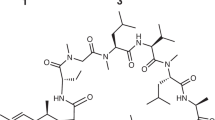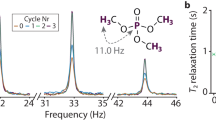Abstract
Nuclear magnetic resonance (NMR) is a fundamental spectroscopic technique for the study of biological systems and materials, molecular imaging and the analysis of small molecules. It detects interactions at very low energies and is thus non-invasive and applicable to a variety of targets, including animals and humans. However, one of its most severe limitations is its low sensitivity, which stems from the small interaction energies involved. Here, we report that dynamic nuclear polarization in liquid solution and at room temperature can enhance the NMR signal of 13C nuclei by up to three orders of magnitude at magnetic fields of ∼3 T. The experiment can be repeated within seconds for signal averaging, without interfering with the sample magnetic homogeneity. The method is therefore compatible with the conditions required for high-resolution NMR. Enhancement of 13C signals on various organic compounds opens up new perspectives for dynamic nuclear polarization as a general tool to increase the sensitivity of liquid NMR.
This is a preview of subscription content, access via your institution
Access options
Access Nature and 54 other Nature Portfolio journals
Get Nature+, our best-value online-access subscription
$29.99 / 30 days
cancel any time
Subscribe to this journal
Receive 12 print issues and online access
$259.00 per year
only $21.58 per issue
Buy this article
- Purchase on Springer Link
- Instant access to full article PDF
Prices may be subject to local taxes which are calculated during checkout




Similar content being viewed by others
References
Ardenkjaer-Larsen, J. H. et al. Facing and overcoming sensitivity challenges in biomolecular NMR spectroscopy. Angew. Chem. Int. Ed. 54, 9162–9185 (2015).
Rossini, A. J. et al. Dynamic nuclear polarization surface enhanced NMR spectroscopy. Acc. Chem. Res. 46, 1942–1951 (2013).
Ni, Q. Z. et al. High frequency dynamic nuclear polarization. Acc. Chem. Res. 46, 1933–1941 (2013).
Green, R. A. et al. The theory and practice of hyperpolarization in magnetic resonance using parahydrogen. Prog. Nucl. Magn. Reson. Spectrosc. 67, 1–48 (2012).
Navon, G. et al. Enhancement of solution NMR and MRI with laser-polarized xenon. Science 271, 1848–1851 (1996).
Bowers, C. R. & Weitekamp, D. P. Transformation of symmetrization order to nuclear-spin magnetization by chemical-reaction and nuclear-magnetic-resonance. Phys. Rev. Lett. 57, 2645–2648 (1986).
Ardenkjaer-Larsen, J. H. et al. Increase in signal-to-noise ratio of >10,000 times in liquid-state NMR. Proc. Natl Acad. Sci. USA 100, 10158–10163 (2003).
Hall, D. A. et al. Polarization-enhanced NMR spectroscopy of biomolecules in frozen solution. Science 276, 930–932 (1997).
Hausser, D. & Stehlik, D. Dynamic nuclear polarization in liquids. Adv. Magn. Reson. 3, 79–139 (1968).
Höfer, P. et al. Field dependent dynamic nuclear polarization with radicals in aqueous solution. J. Am. Chem. Soc. 130, 3254–3255 (2008).
Griesinger, C. et al. Dynamic nuclear polarization at high magnetic fields in liquids. Prog. Nucl. Magn. Reson. Spectrosc. 64, 4–28 (2012).
Franck, J. M., Pavlova, A., Scott, J. A. & Han, S. Quantitative cw Overhauser effect dynamic nuclear polarization for the analysis of local water dynamics. Prog. Nucl. Magn. Reson. Spectrosc. 74, 33–56 (2013).
Prandolini, M. J., Denysenkov, V. P., Gafurov, M., Endeward, B. & Prisner, T. F. High-field dynamic nuclear polarization in aqueous solutions. J. Am. Chem. Soc. 131, 6090–6092 (2009).
van Bentum, P. J. M., van der Heijden, G. H. A., Villanueva-Garibay, J. A. & Kentgens, A. P. M. Quantitative analysis of high field liquid state dynamic nuclear polarization. Phys. Chem. Chem. Phys. 13, 17831–17840 (2011).
Bennati, M., Luchinat, C., Parigi, G. & Türke, M. T. Water 1H relaxation dispersion analysis on a nitroxide radical provides information on the maximal signal enhancement in Overhauser dynamic nuclear polarization experiments. Phys. Chem. Chem. Phys. 12, 5902–5910 (2010).
Müller-Warmuth, W., Vilhjalmsson, R., Gerlof, P., Smidt, J. & Trommel, J. Intermolecular interactions of benzene and carbon tetrachloride with selected free radicals in solution as studied by 13C and 1H dynamic nuclear polarization. Mol. Phys. 31, 1055–1067 (1976).
Wang, X. et al. Optimization and prediction of the electron-nuclear dipolar and scalar interaction in 1H and 13C liquid state dynamic nuclear polarization. Chem. Sci. 6, 6482–6495 (2015).
Lingwood, M. D. & Han, S. G. Dynamic nuclear polarization of 13C in aqueous solutions under ambient conditions. J. Magn. Reson. 201, 137–145 (2009).
George, C. & Chandrakumar, N. Chemical-shift-resolved 19F NMR spectroscopy between 13.5 and 135 MHz: Overhauser-DNP-enhanced diagonal suppressed correlation spectroscopy. Angew. Chem. Int. Ed. 53, 8441–8444 (2014).
Loening, N. M., Rosay, M., Weis, V. & Griffin, R. G. Solution-state dynamic nuclear polarization at high magnetic field. J. Am. Chem. Soc. 124, 8808–8809 (2002).
Türke, M. T., Tkach, I., Reese, M., Hofer, P. & Bennati, M. Optimization of dynamic nuclear polarization experiments in aqueous solution at 15 MHz/9.7 GHz: a comparative study with DNP at 140 MHz/94 GHz. Phys. Chem. Chem. Phys. 12, 5893–5901 (2010).
Reese, M. et al. 1H and 13C dynamic nuclear polarization in aqueous solution with a twofield (0.35 T/14 T) shuttle DNP spectrometer. J. Am. Chem. Soc. 131, 15086–15087 (2009).
Türke, M. T. & Bennati, M. Comparison of Overhauser DNP at 0.34 and 3.4 T with Fremy's salt. Appl. Magn. Reson. 43, 129–138 (2012).
Bucaro, J. & Litovitz, T. Molecular motions in CCl4: light scattering and infrared absorption. J. Chem. Phys. 55, 3585–3588 (1971).
Küçük, S. E. & Sezer, D. Multiscale computational modeling of 13C DNP in liquids. Phys. Chem. Chem. Phys. 18, 9353–9357 (2016).
Jensen, P. R. et al. Hyperpolarized [1, 3-13C2] ethyl acetoacetate is a novel diagnostic metabolic marker of liver cancer. Int. J. Cancer 136, E117–E126 (2015).
Nelson, S. J. et al. Metabolic imaging of patients with prostate cancer using hyperpolarized [1-13C] pyruvate. Sci. Transl. Med. 5, 198ra108 (2013).
Acknowledgements
The authors thank R. Rizzato for discussions on the initial 13C-DNP experiments and I. Tkach for technical support with the 94 GHz EPR spectrometer. Financial support was provided by the Max Planck Society. G.L. acknowledges the Alexander von Humboldt Foundation for a fellowship. C.L. and G.P. acknowledge MIUR PRIN 2012SK7ASN, the European Commission, contracts BioMedBridges 284209 and pNMR 317127, and the EU ESFRI Instruct Core Centre CERM.
Author information
Authors and Affiliations
Contributions
M.B. and G.L. conceived and designed the research. G.L., N.K. and M.L. performed the DNP and EPR experiments. M.L. and N.K. contributed equally to this work. G.P. and C.L. performed and analysed the NMRD experiments. G.L., G.P., C.L. and M.B. wrote the paper. All authors discussed the results and commented on the manuscript.
Corresponding authors
Ethics declarations
Competing interests
The authors declare no competing financial interests.
Supplementary information
Supplementary information
Supplementary information (PDF 614 kb)
Rights and permissions
About this article
Cite this article
Liu, G., Levien, M., Karschin, N. et al. One-thousand-fold enhancement of high field liquid nuclear magnetic resonance signals at room temperature. Nature Chem 9, 676–680 (2017). https://doi.org/10.1038/nchem.2723
Received:
Accepted:
Published:
Issue Date:
DOI: https://doi.org/10.1038/nchem.2723
This article is cited by
-
Hyper-CEST NMR of metal organic polyhedral cages reveals hidden diastereomers with diverse guest exchange kinetics
Nature Communications (2022)
-
Hyperpolarized water as universal sensitivity booster in biomolecular NMR
Nature Protocols (2022)
-
Room-temperature dynamic nuclear polarization enhanced NMR spectroscopy of small biological molecules in water
Nature Communications (2021)
-
13C Dynamic Nuclear Polarization Using Derivatives of TEMPO Free Radical
Applied Magnetic Resonance (2017)



